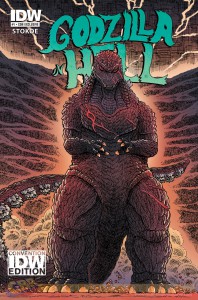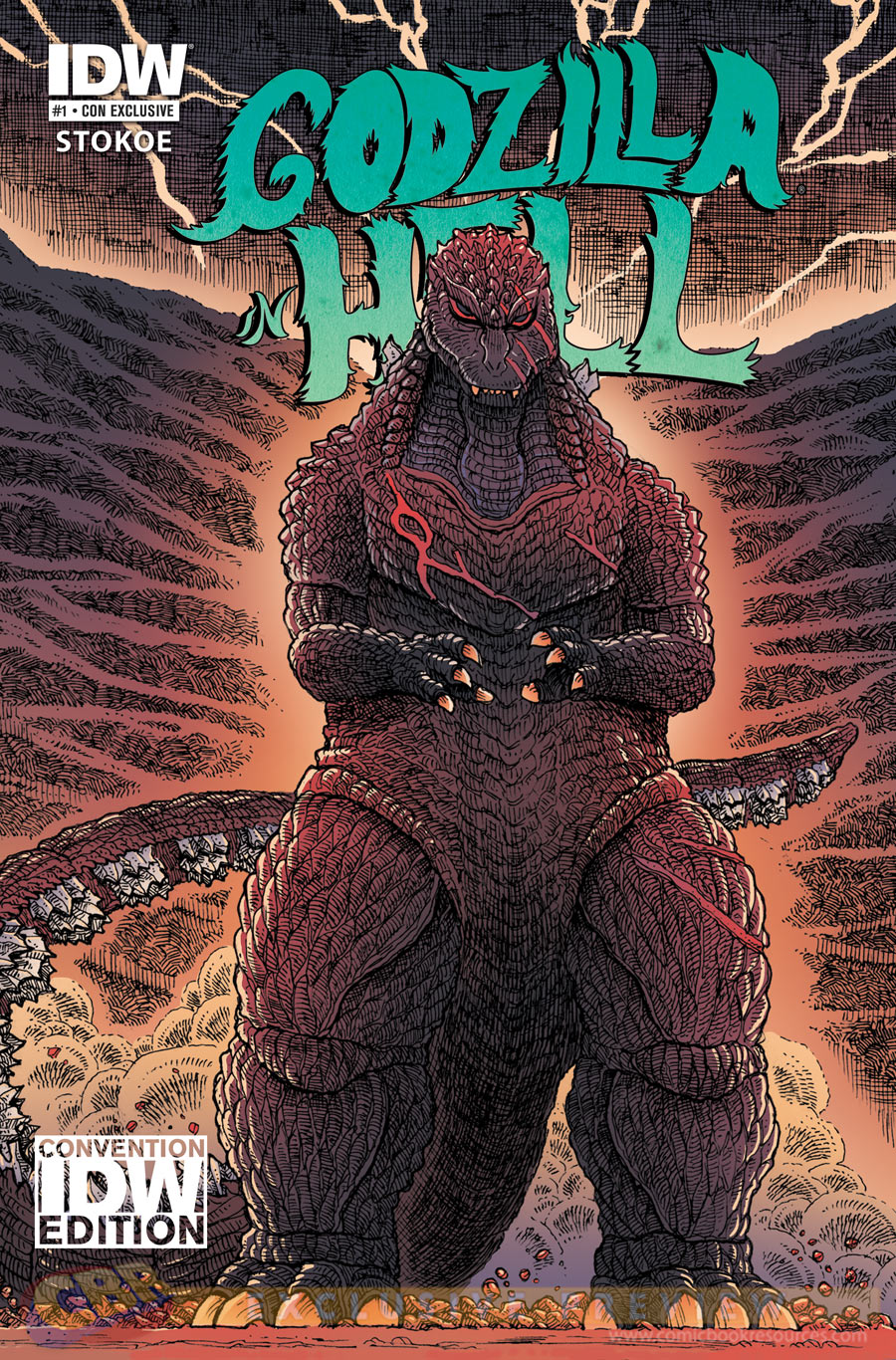
Written/drawn by James Stokoe
Published by IDW
Since the first appearance of Godzilla in Toho’s 1954 film of the same name, the King of Monsters has battled everything from robotic constructs like Mechagodzilla to a giant moth (Mothra), smog monster (Hedorah), and even a creature (Destoroyah) derived from the oxygen destroyer weapon used to defeat him in the original movie. The giant, nuclear-flame breathing dinosaur has faced very few challenges that he could not stomp his way over or bulldoze his way through, the 1998 film adaptation notwithstanding. But, one must wonder, how would Godzilla fare in Dante’s vision of Hell? Thankfully, in Godzilla in Hell, IDW seeks to answer that question.
The book begins with Godzilla plummeting into the “bottomless pit” of Hell. Godzilla is a gigantic beast capable of flattening skyscrapers, yet he is dwarfed by the size of the vast chasm that he falls down into. When he finally reaches bottom, he gets up, shakes it off, and walks past a monolithic stone carved with those famous words from Dante’s Inferno – which, by the way, is only a part of a larger work called The Divine Comedy – “Abandon all hope ye who enter here.” Godzilla immediately uses his signature nuclear breath to destroy the carved stone before moving on to explore more of Hell’s desolate landscape. Eventually, he finds a city where he is taken by surprise by a weird, cephalopod-like monster. The encounter forces him to avoid the city and move further into the wilderness where he is plagued by a massive swarm of human beings who act in a similar manner to a cloud of locusts. After passing this obstacle, the King of Monsters faces a doppelganger of himself that quickly reveals itself to be yet another type of monster in disguise. The issue ends as it began, with Godzilla plummeting down a vast pit, deeper, one must assume, into the bowels of Hell.
James Stokoe acts as writer and artist of this comic, and he does a wonderful job on both counts. While there is no dialogue in the comic – the only words in the entire book are the Inferno quote and a few scattered sound effects in the action scenes – the plot is cohesive and moves forward with purpose, much in the same manner as Godzilla himself. Granted, the plot is not exactly complex as it seems to be nothing more than Godzilla going to Hell and attempting to find a way out. However, this is Godzilla, and destroying cities and beating up other monsters is what he is all about. If you’re reading this comic you probably know that already, and Stokoe’s story will not disappoint you. Likewise, the art is a perfect fit for the book.
Stokoe manages to put Godzilla’s predicament in perspective in the first few panels by showing just how small he is compared to the environment that he has been tossed into. He looks very small compared to the mouth of the pit he has fallen down, and then, to reinforce this role-reversal, Stokoe shows Godzilla looking up at the massive monolith that has Dante’s words carved upon it. On pages 9 and 10,the panels with the huge swarm of human beings who attack the monster en masse reinforces the idea that Godzilla may have bit off more than he can chew and may be paying for his destructive tendencies while on earth. This scene is drawn expertly, with the human swarm an ominous and frightening vision full of minute details – from the naked bodies, flailing arms and legs, and the glimpses of angry faces on some individual figures to the initial terrified expression on Godzilla’s face. One panel reveals that the sheer force of the impact from the swarm causes Godzilla to be pushed backwards. He literally must dig in with his claws to keep from being bowled over. The swarm, more than any other thing he faces in issue #1, hints at the horrible challenges awaiting Godzilla as he wanders deeper into Hell. With art of this caliber, art that moves the story along so smoothly the lack of dialogue and captions is not noticed, nor is it missed. Stokoe tells his story expertly with imagery alone.
Fans of the Godzilla franchise will not be disappointed in this book. The King of Monsters is in true form here. Likewise, those readers into kaiju battles, Pacific Rim, or giant monsters of any kind will be extremely happy reading Godzilla in Hell.

